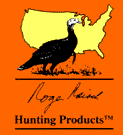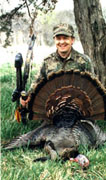Dr. Lovett Williams, in his book, The Voice & Vocabulary Of The Wild Turkey,
(unfortunately it is out of print) provides as good an explanation of the vocabulary of wild turkeys as there is. I highly recommend it to any serious turkey hunter. Too often
turkey hunting authors and professional callers hear a specific sequence of calls and
attach an individual meaning to it, whether or not they ever hear it again under the same
circumstances. As a result, wild turkeys have been credited with dozens of different
calls, the implication being that every good turkey hunter has to know them all to be
successful. Dr. Williams' book provides a clearly written perspective on turkey
calls that should help clear up any misconceptions you may have.
|
Gobbling and
Drumming
|
The Gobble of a wild turkey is the same sound
produced by his barnyard cousin. Sporadic gobbling to reassemble a flock of
scattered toms can be heard occasionally at any time of the year. Gobbling is by far
the most common in the spring, however, to attract hens for mating and to warn away other
toms. It is primarily a long-distance form of communication and is heard most often
when turkeys are on the roost in the morning, and occasionally when they go to roost in
the evening. Most gobblers switch to Spitting and Drumming in
the presence of hens, with less frequent gobbling on the ground.
|
Spitting and
Drumming
|
A sharp
"spittt", followed immediately by a crescendoing "varooOOMMMMM" can
only be heard at close range. Gobblers Spit and Drum as
they strut with hens or to attract nearby hens for mating. Drumming can only be
heard a hundred yards or so under the best conditions, so it is often the last sound a
hunter hears before a gobbler comes into view. It is a subtle sound that many
hunters fail to hear even though a tom is close by.
|
Except for gobbling,
spitting, and drumming, turkeys of both sexes have the same vocabulary. They make a
variety of calls that reflect their mood and intentions. Most of these are derived
from two basic sounds, the Yelp
and the Cluck. They are
able to convey a variety of messages to other turkeys by varying the volume, pitch and
speed of these two sounds and by combing them in different sequences. Variation of
the basic yelp are the calls most commonly heard and used by hunters, a sequence of
rhythmic, musical, evenly spaced notes. Clucks are flat, staccato, unmusical notes
often uttered singly or in irregular patterns. These calls and their variations are
hard to describe with the written word. For this reason, I suggest you get a copy of
the Turkey Hunting Secrets
DVD or Real Turkeys Audio
CD / Cassettes - by
Dr. Lovett E.
Williams, Jr. to hear these sounds and to use to practice your calling with.
|
Yelps
|
Young poults can
make a version of the basic yelp even before their hatch. They Whistle to the incubating hen during their
last hours in the egg, a muted sound much like whistling through your teeth. This is
their basic call for their first few weeks of life. It has the same characteristic
four-or-five-note rhythm and ascending tone as the yelp that they won't be able to make
for months. As poults grow older, whistles become Kee-Kees, louder, coarser whistles that are used to locate other turkeys if the
young birds become lost or separated. As young turkeys mature in their first fall,
kee-kees gradually turn into yelps. The first sign that this is happening occurs as
a string of kee-kees ends in a yelp or two, the fall hunter's favorite call, the Kee-Kee Run. at other times, an initial
yelp or two will break up into a kee-kee. Turkeys at 4 to 6 months old are the
teenagers of the turkey world and have trouble controlling their vocal cords. Young
jakes begin trying to gobble at this time, with the same unpredictable results. Some
will begin kee-keeing or yelping and then break into a gobble, but a strangled or garbled
version of the real thing. Progressively less kee-keeing and more yelping will be
heard as turkeys age, but jakes and young hens will occasionally kee-kee through their
first 18 months. After their first winter, full blown yelping in all its variations
is their most common expression.
|
Yelps (YEOUK) are used in a variety of situations to locate other
turkeys. The Tree Call or Tree Yelps is a very soft,
three-or-four-syllable yelp that can only be heard a short distance. It seems to be
a reassuring call used by members of a roosting flock to establish each other's
location. Plain Yelps are
used by turkeys to call longer distances, generally several notes run together and
considerably louder than tree yelps. They are given by turkeys in the tree and later
on the ground. The Lost Call is a long series of yelps, often a dozen to thirty or more in sequence,
rising and falling in pitch and uttered with what can only be termed a sense of urgency.
It is used by lone turkeys separated from flockmates and desperate to regroup.
Assembly Yelps are coarse
long strings of yelps made by hens in the fall to reassemble young poults.
|
The variety of situations
in which yelps are used, and the variations in pitch, volume, speed and individual voice
quality can be astonishing. As a rule, gobbler yelps are coarser and slower than
those of hens, and young birds have higher voices than adults. The variation is go
great that it is virtually impossible to positively identify the sex of a turkey solely on
the basis of its voice.
|
Excited turkeys tend to
yelp faster, more often and at a higher pitch than the routine talk of undisturbed
flocks. Hence the fast, excited love or mating yelp of the spring turkey
hunter. An undisturbed group of turkeys may utter only occasional single or double
yelps to keep track of flockmates as they feed along. The number of yelps used in a
calling sequence by any given bird can vary as unpredictably as their voice, but a
sequence of four or five notes is most common.
|
Clucks, Putts
and Cackles
|
Variations of the Cluck are as numerous and as difficult to
interpret as yelps. A cluck sounds phonetically much like it is spelled. Soft Pits, high pitched and quiet clucks, are
uttered along with tree calls by roosting birds, and by contented flocks as they feed and
loaf during the day. Two or three pits in quick succession seem to indicate a
disturbed bird. Soft clucks are used as final calls by turkeys to locate each other
when approaching from a distance. A single cluck is
often the only call made by a hen as she approaches a gobbling tom. The cluck of a gobbler is very distinctive, sounding like two large boards
being slapped together.
|
The Alarm Putt is a short, sharp, higher pitched,
staccato version of the cluck. The distinction between a putt and a cluck is clear
at times but less so at others. A clucking turkey may provoke no reaction from
other birds, but the same apparent sound on other occasions will cause every turkey in the
vicinity to jerk its head up and go on guard.
|
A Cutt is a call somewhere between a cluck and
putt. It is also short and sharp, but lacks the higher overtone of the putt.
It is a commanding assembly call that is used by a brood hen to gather her poults.
Other turkeys seen to use it as a more excited, longer range version of the cluck.
In the spring, excited hens close to a gobbler may go into prolonged bouts of cutting and
stimulate gobbling in response. A Cackle is often described as a series of short, rapid yelps, but it sounds more
like a series of cutts, short and staccato and irregularly rising and falling in
rhythm. Hunters describe Fly-Up, Fly-Down and Mating Cackles. They are short, rapid, high-pitched bursts of cutt-like notes that
command the attention and presence of other turkeys, and convey a sense of
excitement. They are heard most often as hens fly up or down from roost and when
they fly across an obstacle like a deep ravine. I have watched turkeys cackle as
they go to or leave a tree, with a rising and falling cutt-cutt-cutt-cutt-cutt-cutt-cutt
sequence, one note for each wing beat.
|
Other Sounds
|
Turkeys make other
sounds besides variations of the yelp and cluck that are hard to describe and harder to
interpret. Most of these are soft calls that carry such a short distance that most
hunters have never heard them. Squeals, Whines and Purrs are
made at close range, mostly to indicate contentment.
|
Soft, contented Feeding Purrs are made by hens and young
birds as they scratch and feed during the day. Louder, sharper, aggressive purrs,
called "Fighting Purrs",
are made by turkeys that are fighting or aggressively circling one another. These
are short and are interspersed with wing flapping. Gobblers chase each other around
and engage in wing flapping, spurring, and neck-wrestling matches, especially in the
spring mating season.
|
A combination Putt-Purr often signifies an alarmed buy
uncertain turkey. I have had hens come to my call in the spring and fall, see me,
and then proceed to walk around my position putt-purring over and over. The putts
became higher pitched and more aggressive as the hens would become more agitated.
Usually they walk away and quiet down, but sometimes they simply stay around, quiet down
and begin feeding. I'm not sure what the putt-purr exactly means.
|
Soft Whines, high pitched, long. monotonic notes
will often stimulate intense strutting in spring gobblers. I have seen toms with
hens go into a strut immediately upon them hearing me do a whine on a call and strut over
to the nearest hen. They calm down after a few minutes of being ignored, relax and
go back to feeding only to strut once more when I whined. I'm uncertain what this
means other than it must be something involving intimate breeding behavior. Clucks
and whines are excellent close range gobbler calls.
|
Turkeys combine all
of these sounds in so many different variations that precise meanings are difficult to
determine. It's enough to say that most Master Turkey Hunters
rely on only a few calls in their repertoire: tree yelps,
fast and snappy spring mating yelps, clucks, cackles, cutts, purrs, and whines.
|
However, a hunter
really only needs to perfect the yelping and clucking sounds to be successful. If you are unfamiliar with all of the sounds turkeys make, or need
a good source to listen to for practicing, at home or in your vehicle, take a look at the Turkey Hunting Secrets
DVD and Real Turkeys Audio
CD / Cassettes - by
Dr. Lovett E.
Williams, Jr.. Tip: Don't practice your
calling in the house, especially when your partner is home! That's a recipe for
divorce and even worse!
|

Turkey Hunting Secrets
DVD
Super Sale
Price: $3.99
ORDER |
| top ^ |
| |
t

God Bless America
|
View
Cart & Check-Out
DECEMBER
2025
877.267.3877
515.299.5388
24 / 7
WE answer
our
phones Personally!
|
|













